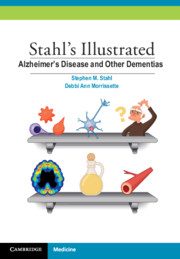Book contents
- Frontmatter
- Dedication
- Preface
- Contents
- CME Information
- Objectives
- Introduction
- Chapter 1 Alzheimer’s Disease
- Chapter 2 Lewy Body Dementias and Other Synucleinopathies
- Chapter 3 Frontotemporal Lobar Degeneration and Tauopathies
- Chapter 4 Other Dementias
- Chapter 5 Treatment of Secondary Behavioral Symptoms of Dementia
- Summary
- References
- Index
- Optional Posttest and CME Certificate
Preface
Published online by Cambridge University Press: 19 October 2021
- Frontmatter
- Dedication
- Preface
- Contents
- CME Information
- Objectives
- Introduction
- Chapter 1 Alzheimer’s Disease
- Chapter 2 Lewy Body Dementias and Other Synucleinopathies
- Chapter 3 Frontotemporal Lobar Degeneration and Tauopathies
- Chapter 4 Other Dementias
- Chapter 5 Treatment of Secondary Behavioral Symptoms of Dementia
- Summary
- References
- Index
- Optional Posttest and CME Certificate
Summary
This book is designed to be fun, with all concepts illustrated by full-color images, figures, and tables supplemented by text. The visual learner will find that this book makes psychopharmacological concepts easier to master, and the non-visual learner may enjoy this book's short explanations of complex psychopharmacological concepts. Each chapter builds upon previous ones, synthesizing information about basic biology, diagnostics, treatment plans, complications, and comorbidities.
Novices may want to approach this book by first looking through all the graphics, gaining a feel for the visual vocabulary on which psychopharmacological concepts rely. After this once-over, we suggest going back through the book to read the text alongside the images. Learning from visual images and textual supplements should reinforce one another, providing novices with solid conceptual understanding at each step along the way.
Readers more familiar with these topics should find that going back and forth between the images and the text enables them to better understand complex psychopharmacological concepts. They may find themselves using this book frequently to refresh their psychopharmacological knowledge, and hopefully, they will refer their colleagues to this desk reference.
This book is intended as a conceptual overview of various topics. The authors provide you with a visual language to better understand the rules of psychopharmacology at the expense of discussing the exceptions to these rules. A References section at the back of this book gives you a good start for more in-depth learning about particular concepts.
Stahl's Essential Psychopharmacology (4th ed.) and Stahl's Essential Psychopharmacology: The Prescriber's Guide (6th ed.) can be helpful supplementary tools for more in-depth information on particular topics. You can also search the Neuroscience Education Institute's website (www.neiglobal.com) for articles, lectures, slides, and courses on psychopharmacological topics.
Whether you are a novice or an experienced psychopharmacologist, this book will hopefully lead you to think critically about the complexities of psychiatric disorders and their treatments.
Best wishes for your educational journey into the fascinating field of psychopharmacology!
- Type
- Chapter
- Information
- Publisher: Cambridge University PressPrint publication year: 2018

